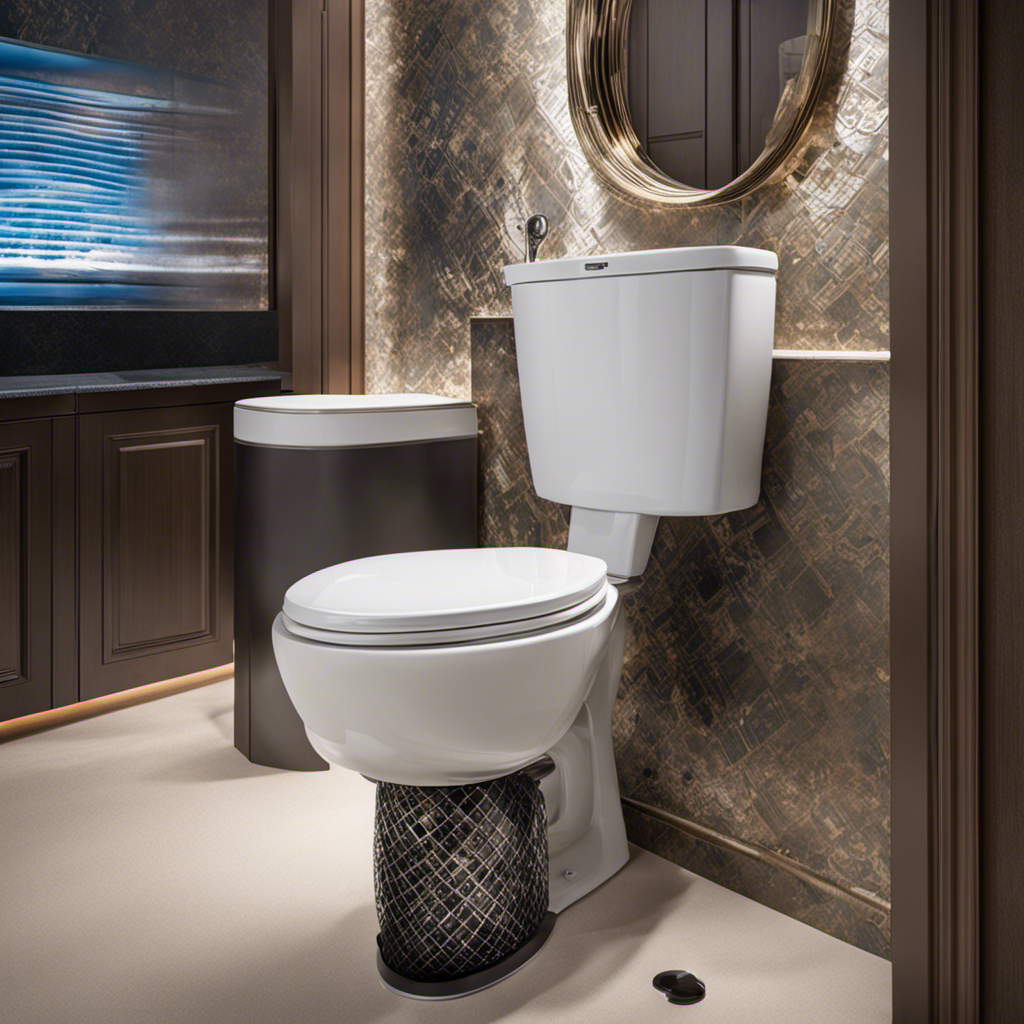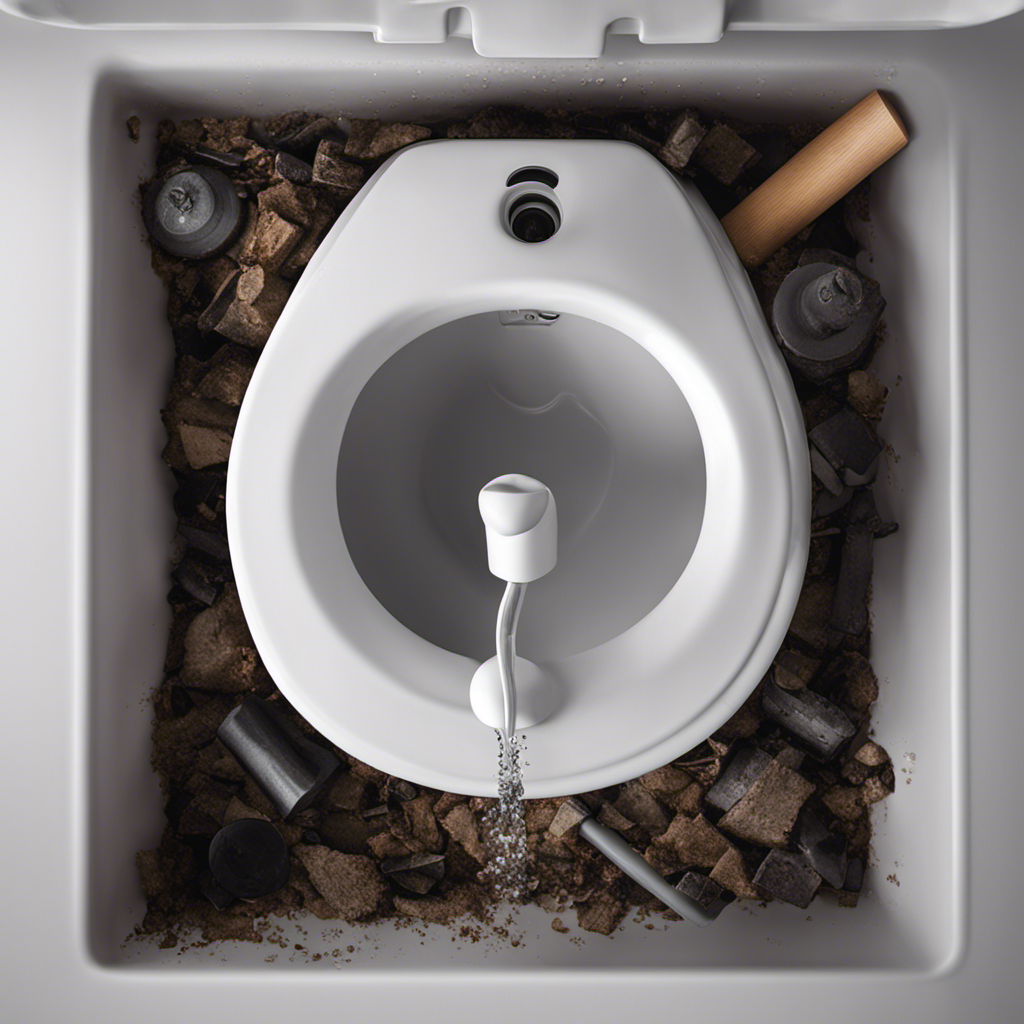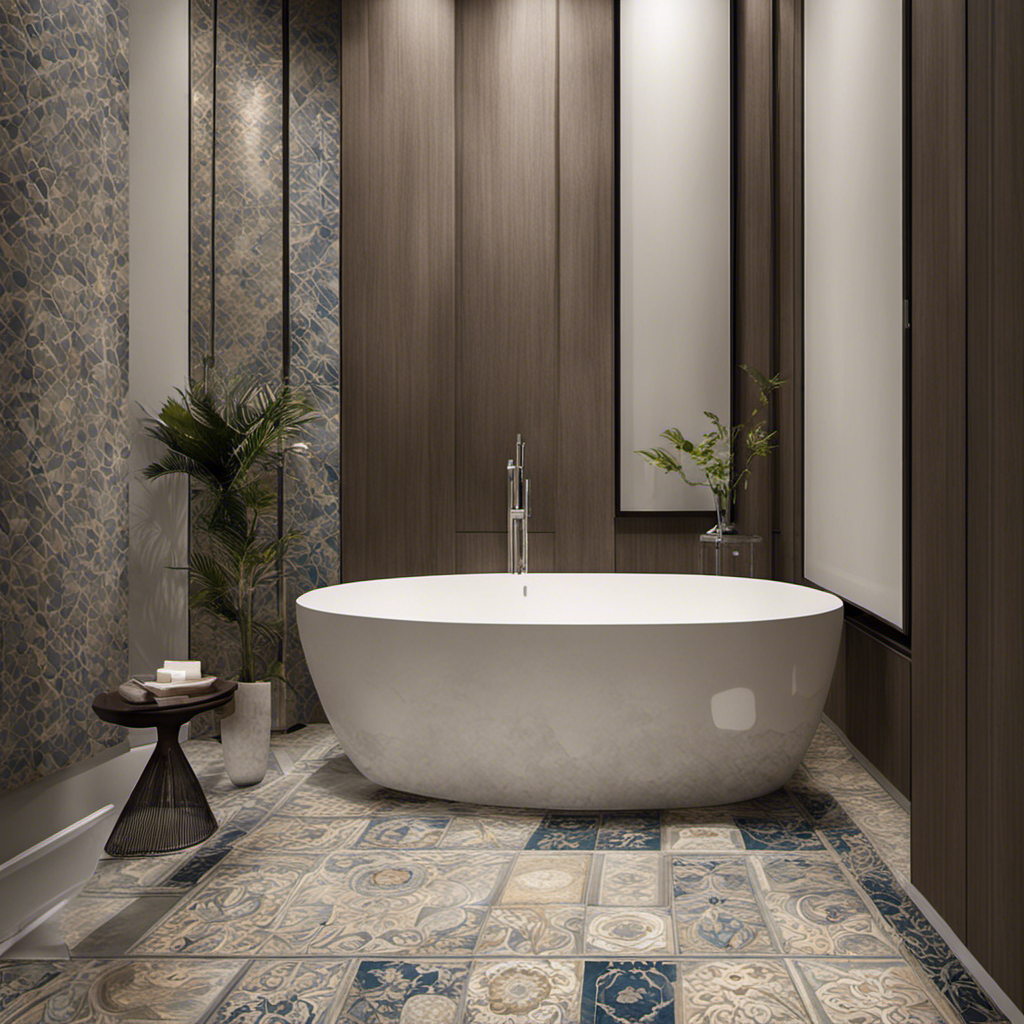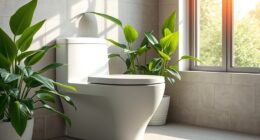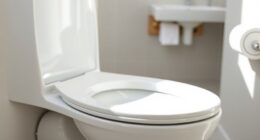As I sit here pondering the marvels of modern plumbing, I can’t help but marvel at the intricate workings of a toilet. From the moment you press that lever, a complex system of valves, jets, and traps springs into action, swiftly transporting waste from your home to the great beyond.
In this article, we will delve into the inner workings of a toilet, exploring how each component plays a vital role in ensuring a clean and efficient flush. So, buckle up and prepare to be enlightened by the inner workings of this humble yet essential household fixture.
Key Takeaways
- The tank holds the water used for flushing the bowl.
- The flush mechanism controls the water flow during a flush.
- Water flow control is achieved through a float valve connected to the water supply.
- Valve maintenance is crucial for a well-functioning toilet system.
The Tank and Bowl
The tank holds the water that is used to flush the bowl. It is an essential component of a toilet system. Proper toilet maintenance is necessary to ensure its efficient functioning. Troubleshooting toilet issues often involves examining the tank and its various parts.
The tank is usually located at the back of the toilet bowl and is connected to the water supply. Inside the tank, you will find a fill valve, a flush valve, and a flapper. The fill valve controls the water level in the tank, while the flush valve is responsible for releasing the water into the bowl during flushing. The flapper acts as a seal to prevent water from continuously flowing into the bowl.
Understanding the tank and its components is crucial for diagnosing and resolving any toilet problems that may arise.
The Flush Mechanism
In the discussion of the flush mechanism, two key points to consider are water flow control and valve functionality.
Water flow control refers to the regulation of the amount of water released during a flush, ensuring an effective and efficient process.
Valve functionality, on the other hand, pertains to the mechanism responsible for opening and closing the water flow, allowing for proper flushing and filling of the tank.
Understanding these aspects is crucial in maintaining a well-functioning toilet system.
Water Flow Control
Toilets use a float valve to control the flow of water. The float valve is connected to the toilet’s water supply and is responsible for regulating the amount of water that enters the tank. By adjusting the position of the float, you can control the water level inside the tank. This is important for maintaining proper flushing performance and preventing overflow.
To ensure the optimal functioning of your toilet’s water flow control, here are some key tips for faucet maintenance and water pressure control:
- Regularly clean the aerator and remove any debris that might affect water flow.
- Check for any leaks or drips and fix them promptly to conserve water.
- Adjust the water pressure at the main valve to avoid excessive pressure that can damage the toilet’s internal components.
- Install a pressure-reducing valve if your water pressure is consistently high.
- Consider using a water-saving faucet aerator to reduce water consumption without compromising performance.
Valve Functionality
To ensure proper functionality, check the valve regularly for any signs of wear and tear.
Valve maintenance is crucial in keeping your toilet working efficiently. If you notice any leaks, difficulty in flushing, or inconsistent water flow, it may be due to valve issues.
Troubleshooting the valve involves inspecting the seals and gaskets for any cracks or damage. If necessary, replace them to prevent water leakage.
Additionally, check the valve’s connections to ensure they are tight and secure. A loose connection can lead to water wastage and reduced flushing power.
By regularly maintaining and troubleshooting the valve, you can prevent costly repairs and extend the lifespan of your toilet.
Now, let’s move on to the next section about the fill valve.
The Fill Valve
In this discussion, I will be addressing the key points regarding the fill valve:
-
Water flow control: The fill valve is responsible for controlling the water flow inside the toilet tank. It regulates the amount of water that enters the tank, maintaining the desired water level. Understanding how to control the water flow is essential for proper functionality.
-
Auto-refill after flushing: After each flush, the fill valve automatically refills the tank with water to the desired level. This ensures that the toilet is ready for the next use. Knowing how the auto-refill process works can help troubleshoot any issues that may arise.
-
Replacing worn-out valves: Over time, fill valves can become worn-out and may need to be replaced. It is important to know when to replace a worn-out valve to prevent water leaks or other problems. Regular maintenance and inspection can help identify when a valve needs to be replaced.
Water Flow Control
Ensure that you adjust the water flow control to regulate the amount of water used for each flush. This is an important feature in toilets as it allows you to control the water pressure and conserve water. The flow control is typically located on the fill valve, which is responsible for refilling the tank after each flush.
By adjusting this control, you can minimize water wastage and ensure efficient flushing. Here are five key points about water flow control:
- The water flow control helps you regulate the amount of water used for flushing.
- It is typically located on the fill valve, which is connected to the water supply.
- By adjusting the flow control, you can increase or decrease the water pressure.
- This control is especially useful in areas with low water pressure, as it can help improve the flushing performance.
- The flow control works in conjunction with the float valve mechanism to maintain the water level in the tank and ensure proper flushing.
Auto-Refill After Flushing
After flushing, the tank will automatically refill with water to prepare for the next use. This auto-refill mechanism is an essential part of toilet maintenance and ensures that the toilet is ready for the next user.
The refill process starts as soon as the flush valve closes. A float valve, also known as a ballcock, is responsible for controlling the water level in the tank. When the water level drops, the float valve opens, allowing water to flow into the tank from the water supply line. Once the water reaches the desired level, the float valve closes, stopping the flow of water.
This auto-refill feature is designed to conserve water by only refilling the tank to the necessary level, reducing wastage and promoting water conservation.
Replacing Worn-Out Valves
When valves become worn out, they should be replaced to maintain proper functioning. Toilet maintenance is crucial to avoid common issues that may occur over time. Here are five troubleshooting tips to keep your toilet in top shape:
- Check for leakage around the base of the toilet.
- Ensure the water level in the tank is at the appropriate level.
- Test the flush mechanism to ensure it is working smoothly.
- Clean the jets and siphon holes regularly to prevent clogs.
- Inspect the flapper for any signs of damage or wear.
In order to maintain a properly functioning toilet, it is important to address any worn-out valves promptly.
The Flapper or Flush Valve
The flapper or flush valve controls the water flow in a toilet. It is a crucial component that ensures proper flushing and refilling of the tank. To maintain the flapper, regular inspection is necessary to check for any signs of wear or damage. If you notice any leakage or a weak flush, it may be time to replace the flapper. Flapper replacement is a simple task that can be done by following a few steps. First, turn off the water supply to the toilet. Then, remove the old flapper by disconnecting it from the chain and unscrewing any attachments. Finally, install the new flapper by attaching it to the chain and securing it in place. Regular flapper maintenance and timely replacement will help keep your toilet functioning efficiently.
| Step | Instructions |
|---|---|
| 1 | Turn off the water supply to the toilet |
| 2 | Disconnect the old flapper from the chain |
| 3 | Unscrew any attachments holding the flapper |
| 4 | Install the new flapper by attaching it to the chain and securing it in place |
The Siphon Jet
Now that we understand how the flapper or flush valve functions, let’s dive into another crucial component of toilet design: the siphon jet. This powerful mechanism is responsible for creating the necessary force to flush waste effectively.
The siphon jet is a small, angled hole located near the bottom of the toilet bowl. When you activate the flush, water rushes into the bowl, filling it rapidly. This sudden influx of water increases the pressure inside the bowl.
Here are five key points to know about the siphon jet:
- It harnesses the power of water pressure to create a strong flushing action.
- The angled design helps direct the water towards the waste, allowing for efficient removal.
- The siphon jet is strategically positioned to maximize its effectiveness.
- It works in conjunction with the flapper or flush valve to initiate the flushing process.
- The siphon jet is a critical element of modern toilet designs, ensuring proper sanitation and waste removal.
The Trap and Drain
Once you flush, water flows through the trap and drain, carrying away the waste from the bowl. The trap is a curved section of pipe located beneath the toilet bowl. Its purpose is to prevent unpleasant odors from entering the bathroom by creating a water seal. The drain, on the other hand, is a pipe that connects the trap to the sewer line. It allows the waste and water to be transported out of the house to the sewage system. To ensure proper functioning of the trap and drain, regular plumbing maintenance is essential. This includes checking for any toilet clogs and clearing them promptly to prevent backups and damage. Regular inspections and cleaning can help maintain the efficiency of the trap and drain, ensuring the smooth operation of your toilet system.
| Trap | Drain |
|---|---|
| Curved pipe | Connects trap |
| Water seal | Sewer line |
| Odor control | Waste removal |
Frequently Asked Questions
How Does the Toilet Handle Waste Disposal and Prevent Odors From Escaping?
Toilet maintenance is crucial to prevent odors. Regular cleaning with suitable products helps keep the toilet clean and odor-free. Proper waste disposal involves a flushing mechanism that directs waste into the sewage system, preventing any odors from escaping.
Can a Toilet Be Easily Unclogged if Something Gets Stuck in the Drain?
Yes, a toilet can be easily unclogged if something gets stuck in the drain. There are various DIY toilet unclogging techniques that can be used to maintain the toilet drain and keep it clear.
What Are the Common Signs of a Malfunctioning Toilet and How Can They Be Fixed?
When a toilet malfunctions, common signs include a constantly running toilet, weak flushing power, or water leaking from the base. These issues can be fixed by adjusting the water pressure, replacing the toilet flapper, or calling a plumber.
Is It Possible to Install a Bidet Feature on a Standard Toilet?
Yes, it is possible to install a bidet feature on a standard toilet. Bidet installation offers numerous benefits such as improved cleanliness, reduced toilet paper usage, and enhanced personal hygiene.
Are There Any Eco-Friendly Options Available for Reducing Water Usage in Toilets?
When it comes to eco-friendly toilet options, there are a variety of water-saving technologies available. These innovative features help reduce water usage without compromising efficiency, making them a great choice for those looking to conserve resources.
Conclusion
After understanding the intricate inner workings of a toilet, I’m amazed by the precision and efficiency of its design.
From the moment the flush mechanism is activated, a synchronized dance begins. The fill valve swiftly fills the tank, while the flapper releases a torrent of water, propelled by the powerful siphon jet.
The trap and drain work seamlessly to ensure the waste is whisked away. It’s a marvel of engineering, a symphony of components working together to create a clean and hygienic experience.
